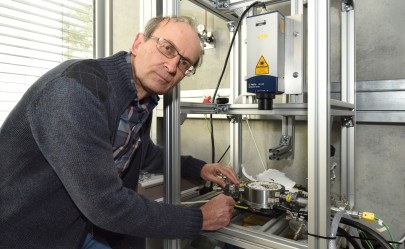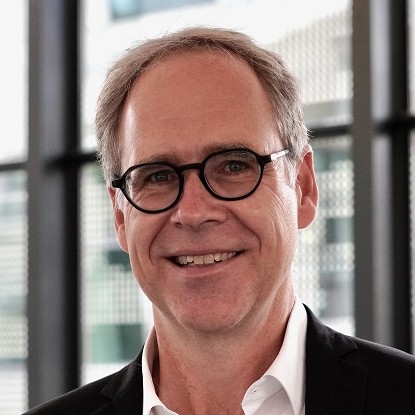Professor Dr Dragan Damjanovic
Age: 65
My research areas: fundamental and applied investigations of piezoelectric, ferroelectric and dielectric properties of a broad class of materials, from oxide ceramics, crystals, and thin films to polymers and hybrid organo-metallic materials.
Name of my University / Research Institute: Institute of Materials, Ecole polytechnique fédérale de Lausanne (Swiss Federal Institute of Technology in Lausanne)
Research period at the TU Darmstadt: October to December 2022, March to May 2023 and fall 2023
Programme: Humboldt Research Award Programme
My field of research is fascinating. The best way to explain it to non-specialists is…
I focus on materials that interconvert mechanical and electrical energy. I try to link properties of materials on the scale of everyday devices with processes which are happening on scales from macroscopic (millimetre) to the scale of atoms (picometer). For this, I use a range of experimental and computation methods. The most fascinating feature for me is how new phenomena often appear at a given spatial scale that cannot be easily predicted from the processes happening at a smaller scale.
What research questions are you currently working on?
I am interested in the electro-mechanical mechanisms that (i) lead to properties that are forbidden by the symmetry of the material, or (ii) lead to unexpectedly large properties in a given material. I also look at effects of chemical processes and light on electro-mechanical coupling. I am particularly interested in how electro-mechanical coupling is affected by presence of defects in the material. The long-range ionic motion seems to have a large effect on electro-mechanical properties.
My most important success in research to date is…
This would probably be description of how domain wall displacement contributes to the piezoelectric (electro-mechanical) and dielectric hysteresis in ferroelectrics.
Will the results of your research have a concrete impact on our everyday lives now or at some later date?
Materials and properties I study are used in a wide range of applications, from medical ultrasonic imaging via pressure sensing to fuel injection. An important parameter in these applications is how internal interfaces (domain walls) move under external electric field or mechanical force. Together with my students and collaborators, we have developed methods how to model and investigate displacement of domain walls.
What innovative developments are you expecting in your field of research in the next few years?
The concept of “contributing mechanisms to a given property of the material” is very important both fundamentally and for applications and has to be developed for each new class of materials. In the case of piezoelectrics a deeper understanding of mechanisms of piezoelectricity is needed for lead-free materials. We are still rather far from a sufficiently thorough understanding.
I became a researcher because…
I like problem solving and creative work that are inherent to the research and science. The science and research provide not only for a lifetime of a high-quality entertainment but also many opportunities to give service to the society. I also like scientific approach to the life problems and challenges faced by the civilisation.
I have chosen TU Darmstadt because…
TU Darmstadt is a world leader and has excellent reputation in the field of electroceramics. It has very talented and well educated students and postdocs, with many of whom I have worked in the past. I have been collaborating with Professor Jürgen Rödel during the past ten years. Professor Rödel has built one of the world’s largest and most influential laboratories in the field of lead free piezoelectric materials.
What reputation does German research enjoy in your home country?
German research has excellent reputation in Switzerland and we have developed strong collaboration with German research organisations and universities. At my home university in Switzerland (EPFL) we have a large number of students, postdoctoral researchers, scientists and professors who came from Germany. The collaboration with German industry is also well developed, and more can be done in the future.
What lasting impressions will you take back home with you from your time in Darmstadt and Germany?
I am impressed with the excellent working conditions, good organization and the skilled personnel at all levels at TU Darmstadt. I found people in Germany to be welcoming and helpful. I also like the international character of TU Darmstadt. Darmstadt is a pleasant city with beautiful environments, and I enjoy long walks even in the city itself. The geographic position of Darmstadt in the center of Germany and excellent public transport allow me to travel and see interesting cities in other parts of Germany.
Questionnaire for the host
Guest of: Professor Dr Jürgen Rödel
Department: Department of Materials- and Geosciences
What did you appreciate most about your guest, or what is it that impressed you most favorably…
Dragan has very deep physical understanding and understands its relevance for application. He is an excellent and patient teacher of theoretical background. At the same time he helps our postdocs to set up new experimental equipment in the laboratory and verifies its accuracy first himself. In working with him, one never worries asking him any stupid question.
You, your team, and TU Darmstadt benefit from your guest’s…
Dragan is complementing our experimental equipment. As we are now venturing into two new fields (effect of precipitates and off dislocation networks) on domain wall mobility, we could not find any better scientist worldwide to help us explore these very new effects. Dragan himself developed both the experimental quantification as well as the theoretical understanding of domain wall movement, which is the parameter we will be tuning with our new approaches.







